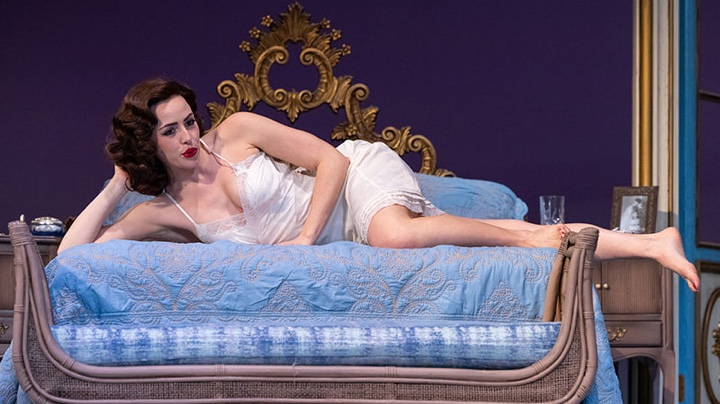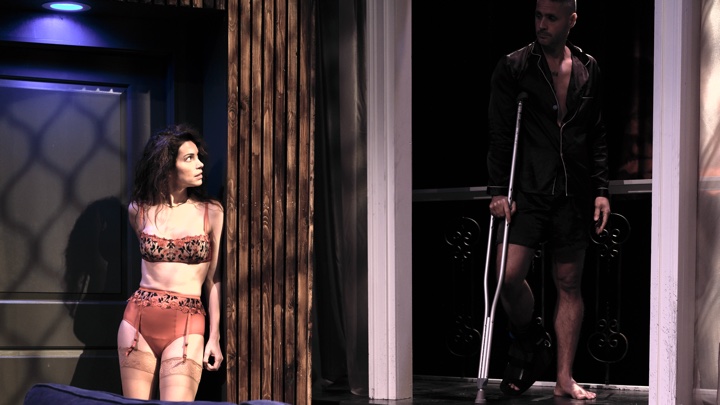

Theatre at St. Clement’s (Photo: © Ismaeel Skalli)
“One of those no-neck monsters hit me with a hot buttered biscuit,” says Maggie, who has returned to her room, “so I have t’ change!” Moments later, the stage directions indicate that she steps out of her dress and stands in a slip of ivory satin and lace.
Surely anyone who has seen Cat on a Hot Tin Roof will never forget Tennessee Williams’ astonishing opening gambit. Within the first minute, we have a preview of everything to come. Maggie is the Southern belle despoiled and even mocked. (That hot buttered biscuit, thrown at her by a pack of shrieking brats, is a cruel “bun in the oven” reminder that Maggie is problematically childless.)
Left literally and figuratively in a state of disrobed vulnerability, her situation is made worse because Brick, her injured husband, who is alone in the bedroom with her, couldn’t care less. He’s absorbed in the only thing that brings him comfort: drinking. Maggie is essentially left to fend for herself, using her brains and body. And for nearly three thrilling hours of theater, that’s just what she does.
Welcome to Tennessee Williams’ South. To be precise, it’s the Mississippi Delta here in Cat, though through other plays he casts his net wider. The action is set nearly a century after Reconstruction, but social roles haven’t shifted as much as you might expect. Maggie is one of many Williams’ female characters who were raised to be primarily ornamental, but it hasn’t worked out that way. Instead, their lives are a constant uphill climb, impeded and sometimes destroyed by broken men who fail them in different ways.

Walnut Street Theatre (Photo: Mark Garvin)
It’s the essence of the playwright’s genius that he sees these women, with all their faults, as fundamentally sympathetic and even heroic. Would that more directors treated them as well.
Through a lucky coincidence of timing, I was able to catch up with Cat, a play I adore, in two productions playing at the same time. Philadelphia’s Walnut Street offers an expansive, centrist version that will be comfortingly familiar to fans of the film. New York’s Theatre at St. Clement’s is showcasing an intimate, pared-down, strikingly bold updating.
Both shows had their strong points; neither achieved the shattering insights I was hoping for. But I’m certainly glad I saw them. Independently and together, these shows are a reminder of Williams’ greatness… and even more, of his continuing relevance.
The large Walnut Street stage helps reinforce the grandeur at the heart of Cat. This is the kind of lavish plantation that millions of dollars can build, and the Pollitt family—particularly good-hearted but gauche Big Mama—is happy to showcase their affluence.

Walnut Street Theatre (Photo: Mark Garvin)
Roman Tatarowicz’s scenery cannily brings the outside into Brick and Maggie’s bedroom with an overhanging tree branch and a constructed wall of shutters, the latter a nice touch in reminding us that this open, airy house (Big Mama won’t allow closed doors) holds a lot of secrets.
In a generally strong cast, the revelation here is Scott Greer’s Big Daddy, which substitutes a tightly coiled sense of darkness for the usual bluster. Greer—consistently one of Philadelphia’s finest actors—plays much of his role in a quiet, simmering way that feels new-minted.
There are terrific supporting performances from Johnnie Hobbs Jr. (Rev. Tooker), Michael Toner (Dr. Baugh), and David Bardeen (Gooper). Wendy Scharfman brings a touching note of dignity to the much-maligned Big Mama; I wish there were more of this in Alicia Roper’s amusing Mae, a character who here is made to look too frowzy, a fault also in the film. (Mae was a former pageant queen, and Big Daddy makes the point that she and Maggie have “the same look.”)
Brick is an immensely tricky role: so much of it is silent listening, but the audience needs to sense his uneasy presence throughout. Matthew Amira has the physicality, but he’s too much of a cipher. Alanna Smith is a highly credible Maggie, resourceful and finding variety in her steeple-chase near-monologue that opens the play.

Theatre at St. Clement’s (Photo: © Ismaeel Skalli)
Smith would be even more effective had director Bernard Havard not overstated the character’s sexual wiles, but sadly this is a common mistake. Havard has Smith frequently posing on the bed, stroking her body, and generally preening. This is a misreading of the central metaphor. Maggie is not a sex kitten; she’s a cat on a hot tin roof, who needs to tread with absolutely delicacy over the minefield of life.
A brief sidebar: My sense is that Elizabeth Taylor in the 1958 film and Elizabeth Ashley in a much-praised 1974 revival, forever changed the way we view Maggie, emphasizing her glamour and sexuality. Photographs of the role’s originator, Barbara Bel Geddes, suggest something quite different—a fresh-faced girl-next-door type, which was certainly Bel Geddes’s trademark. (Several friends who saw the original said she was sensational.) Taylor and Ashley may also be responsible for changing our physical sense of Maggie from blonde to smoldering brunette.
If the Walnut Street production points up Maggie’s allure, at Saint Clement’s director Joe Rosario goes way beyond it. Gone is the slip of ivory satin and lace, with its vague suggestion of wedding gowns and purity. Within seconds, the Maggie here (actress Courtney Henggler) has stripped down to a fire engine red bra, panties and garter belt.
Gone too is even a whiff of Southern charm. Henggler skillfully rattles through much of the scene at breakneck speed, often just barely suppressing a snarl. (To be fair, at this point we’ve already seen Matt de Rogatis as a shirtless, heavily tattooed Brick, dousing himself in an onstage shower, so there is some equal opportunity smoldering going on.) The plantation here looks cramped indeed, with a tacky bar front and center.
Before you recoil in horror, let me add that there really is a point here. Rosario’s updated version brings out some powerful and intriguing psychological and social dynamics, especially where Brick is concerned. And it’s interesting how much of Williams’ often poetic language survives this kind of blunt prose performance.
Cat is a play that fearlessly explores life’s ugly corners. Through much of this, what I was most reminded of is the kind of Schadenfreude spectacles so popular on reality TV, where moments of maximum embarrassment are sometimes shown again and again.
Some of it doesn’t work at all. Frederick Weller, a spellbinding actor in the right thing, is ludicrously miscast here as Big Daddy. At 56, he’s ten years too young for the part, and he looks a decade younger than that. He’s scrappy and oafish, which flies in the face of everything we know about Big Daddy. (Weller would be far better as Gooper.) And he makes even less sense paired with Alison Fraser’s Big Mama.
Fraser is one of the two triumphs here—a stunning reinvention of the role. All shellacked glamour with a glinting hard-edge, Fraser breathes new life into every moment, and also seems profoundly connected to Brick.
And here, it is indeed Brick—Matt de Rogatis—who is the other revelation. I’ve never seen a Brick whose emotional life felt so fully present throughout, and the scenes in which his forbidden attraction to Skipper, his doomed high school buddy, are explored are heartbreakingly vivid here.
In both productions, there is of course another revelation—Williams himself, whose nearly 70 year old play, seen in two startlingly different contexts, burns more brightly than ever.

























Comments